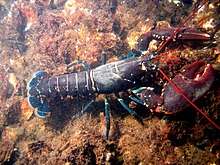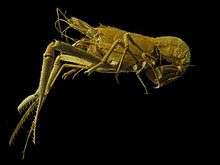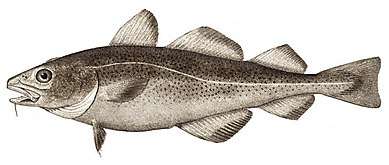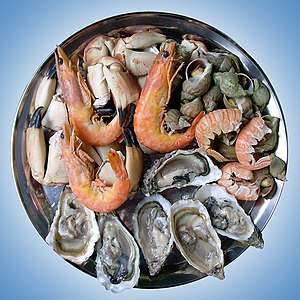Lobster
Lobsters are a family (Nephropidae, sometimes also Homeridae) of large marine crustaceans.
| Lobster | |
|---|---|
 | |
| European lobster (Homarus gammarus) | |
| Scientific classification | |
| Kingdom: | Animalia |
| Phylum: | Arthropoda |
| Subphylum: | Crustacea |
| Class: | Malacostraca |
| Order: | Decapoda |
| Superfamily: | Nephropoidea |
| Family: | Nephropidae Dana, 1852 |
| Genera[1] | |
| |
Lobsters have long bodies with muscular tails, and live in crevices or burrows on the sea floor. Three of their five pairs of legs have claws, including the first pair, which are usually much larger than the others. Highly prized as seafood, lobsters are economically important, and are often one of the most profitable commodities in coastal areas they populate.[2] Commercially important species include two species of Homarus (which looks more like the stereotypical lobster) from the northern Atlantic Ocean, and scampi (which looks more like a shrimp, or a "mini lobster") – the Northern Hemisphere genus Nephrops and the Southern Hemisphere genus Metanephrops. Although several other groups of crustaceans have the word "lobster" in their names, the unqualified term "lobster" generally refers to the clawed lobsters of the family Nephropidae.[3] Clawed lobsters are not closely related to spiny lobsters or slipper lobsters, which have no claws (chelae), or to squat lobsters. The closest living relatives of clawed lobsters are the reef lobsters and the three families of freshwater crayfish.
Description

Body
Lobsters are invertebrates with a hard protective exoskeleton.[4] Like most arthropods, lobsters must moult to grow, which leaves them vulnerable. During the moulting process, several species change color. Lobsters have eight walking legs; the front three pairs bear claws, the first of which are larger than the others. The front pincers are also biologically considered legs, so they belong in the order Decapods ("ten-footed").[5] Although lobsters are largely bilaterally symmetrical like most other arthropods, some genera possess unequal, specialized claws.
Lobster anatomy includes two main body parts: the cephalothorax and the abdomen. The cephalothorax fuses the head and the thorax, both of which are covered by a chitinous carapace. The lobster's head bears antennae, antennules, mandibles, the first and second maxillae. The head also bears the (usually stalked) compound eyes. Because lobsters live in murky environments at the bottom of the ocean, they mostly use their antennae as sensors. The lobster eye has a reflective structure above a convex retina. In contrast, most complex eyes use refractive ray concentrators (lenses) and a concave retina.[6] The lobster's thorax is composed of maxillipeds, appendages that function primarily as mouthparts, and pereiopods, appendages that serve for walking and for gathering food. The abdomen includes pleopods (also known as swimmerets), used for swimming as well as the tail fan, composed of uropods and the telson.
Lobsters, like snails and spiders, have blue blood due to the presence of hemocyanin, which contains copper.[7] In contrast, vertebrates and many other animals have red blood from iron-rich hemoglobin. Lobsters possess a green hepatopancreas, called the tomalley by chefs, which functions as the animal's liver and pancreas.[8]
Lobsters of the family Nephropidae are similar in overall form to a number of other related groups. They differ from freshwater crayfish in lacking the joint between the last two segments of the thorax,[9] and they differ from the reef lobsters of the family Enoplometopidae in having full claws on the first three pairs of legs, rather than just one.[9] The distinctions from fossil families such as the Chilenophoberidae are based on the pattern of grooves on the carapace.[9]
Coloring
Typically, lobsters are dark colored, either bluish green or greenish brown as to blend in with the ocean floor, but they can be found in a multitude of colors.[10][11] Lobsters with atypical coloring are extremely rare, accounting for only a few of the millions caught every year, and due to their rarity, they usually are not eaten, instead being released back into the wild or donated to aquariums. Often, in cases of atypical coloring, there is a genetic factor, such as albinism or hermaphroditism. Notably, the New England Aquarium has a collection of such lobsters, called the Lobster Rainbow, on public display. Special coloring does not appear to have an effect on the lobster's taste once cooked; with the exception of albinos, all lobsters possess astaxanthin, which is responsible for the bright red color lobsters turn after being cooked.[12]
| Color | Prevalence | Notes | Notable specimens |
|---|---|---|---|
| albino | 1 in 100,000,000[13] | Also called white; translucent; ghost; crystal.[14][15][16] | |
| "cotton candy" | 1 in 100,000,000[17] | Also called pastel.[18] Possibly a sub-type of albino.[17] | |
| blue | 1 in 1,000,000[19] to 1 in 2,000,000[20][21][22] | Caused by a genetic defect.[19] | Lord Stanley (2019, Massachusetts)[21][22](2019, St. Louis)[23] |
| calico | 1 in 30,000,000[24] | Eve (2019, Maryland)[25] | |
| orange | 1 in 30,000,000[26] | ||
| split-colored | 1 in 50,000,000[27] | Almost all split-coloreds are hermaphroditic.[14] | |
| "Halloween" | 1 in 50,000,000[27] to 1 in 100,000,000[28] | Sub-type of split-colored, specifically orange and black.[29] | Pinchy (2012, Massachusetts)[30] |
| red | 1 in 10,000,000[29] to 1 in 30,000,000[31] | ||
| yellow | 1 in 30,000,000[32] |
Longevity
Lobsters live up to an estimated 45 to 50 years in the wild, although determining age is difficult.[33] In 2012, a report was published describing how growth bands in calcified regions of the eyestalk or gastric mill in shrimps, crabs and lobsters could be used to measure growth and mortality in decapod crustaceans.[34] Without such a technique, a lobster's age is estimated by size and other variables; this new knowledge "could help scientists better understand the population and assist regulators of the lucrative industry".[35]
Research suggests that lobsters may not slow down, weaken or lose fertility with age, and that older lobsters may be more fertile than younger lobsters. This longevity may be due to telomerase, an enzyme that repairs long repetitive sections of DNA sequences at the ends of chromosomes, referred to as telomeres. Telomerase is expressed by most vertebrates during embryonic stages, but is generally absent from adult stages of life.[36] However, unlike most vertebrates, lobsters express telomerase as adults through most tissue, which has been suggested to be related to their longevity. Telomerase is especially present in 'Green Spotted' lobsters - whose markings are thought to be produced by the enzyme interacting with their shell pigmentation [37][38][39] Lobster longevity is limited by their size. Moulting requires metabolic energy and the larger the lobster, the more energy is needed; 10 to 15% of lobsters die of exhaustion during moulting, while in older lobsters, moulting ceases and the exoskeleton degrades or collapses entirely leading to death.[40][41]
Lobsters, like many other decapod crustaceans, grow throughout life and are able to add new muscle cells at each moult.[42] Lobster longevity allows them to reach impressive sizes. According to Guinness World Records, the largest lobster ever caught was in Nova Scotia, Canada, weighing 20.15 kilograms (44.4 lb).[43][44]
Ecology
Lobsters live in all oceans, on rocky, sandy, or muddy bottoms from the shoreline to beyond the edge of the continental shelf. They generally live singly in crevices or in burrows under rocks.[45]
Lobsters are omnivores and typically eat live prey such as fish, mollusks, other crustaceans, worms, and some plant life. They scavenge if necessary, and are known to resort to cannibalism in captivity. However, when lobster skin is found in lobster stomachs, this is not necessarily evidence of cannibalism – lobsters eat their shed skin after moulting.[46] While cannibalism was thought to be nonexistent among wild lobster populations, it was observed in 2012 by researchers studying wild lobsters in Maine. These first known instances of lobster cannibalism in the wild are theorized to be attributed to a local population explosion among lobsters caused by the disappearance of many of the Maine lobsters' natural predators.[47]
In general, lobsters are 25–50 cm (10–20 in) long, and move by slowly walking on the sea floor. However, when they flee, they swim backward quickly by curling and uncurling their abdomens. A speed of 5 m/s (11 mph) has been recorded.[48] This is known as the caridoid escape reaction.
Symbiotic animals of the genus Symbion, the only member of the phylum Cycliophora, live exclusively on lobster gills and mouthparts.[49] Different species of Symbion have been found on the three commercially important lobsters of the North Atlantic Ocean – Nephrops norvegicus, Homarus gammarus, and Homarus americanus.[49]
As food


Lobster recipes include lobster Newberg and lobster Thermidor. Lobster is used in soup, bisque, lobster rolls, and cappon magro. Lobster meat may be dipped in clarified butter, resulting in a heightened flavor. Cooks boil or steam live lobsters. When a lobster is cooked, its shell's color changes from blue to orange because the heat from cooking breaks down a protein called crustacyanin, which suppresses the orange hue of the chemical astaxanthin, which is also found in the shell.[50]
According to the United States Food and Drug Administration (FDA), the mean level of mercury in American lobster between 2005 and 2007 was 0.107 ppm.[51]
History
In North America, the American lobster did not achieve popularity until the mid-19th century, when New Yorkers and Bostonians developed a taste for it, and commercial lobster fisheries only flourished after the development of the lobster smack,[52] a custom-made boat with open holding wells on the deck to keep the lobsters alive during transport.[53]
Prior to this time, lobster was considered a poverty food or as a food for indentured servants or lower members of society in Maine, Massachusetts, and the Canadian Maritimes. Some servants specified in employment agreements that they would not eat lobster more than twice per week,[54] however there is limited evidence for this.[55][56] Lobster was also commonly served in prisons, much to the displeasure of inmates.[57] American lobster was initially deemed worthy only of being used as fertilizer or fish bait, and until well into the 20th century, it was not viewed as more than a low-priced canned staple food.[58]
As a crustacean, lobster remains a taboo food in the dietary laws of Judaism and certain streams of Islam. (See also: Kashrut, Halal, and List of halal and kosher fish)[59]
Grading
Caught lobsters are graded as new-shell, hard-shell, or old-shell, and because lobsters which have recently shed their shells are the most delicate, an inverse relationship exists between the price of American lobster and its flavor. New-shell lobsters have paper-thin shells and a worse meat-to-shell ratio, but the meat is very sweet. However, the lobsters are so delicate, even transport to Boston almost kills them, making the market for new-shell lobsters strictly local to the fishing towns where they are offloaded. Hard-shell lobsters with firm shells, but with less sweet meat, can survive shipping to Boston, New York, and even Los Angeles, so they command a higher price than new-shell lobsters. Meanwhile, old-shell lobsters, which have not shed since the previous season and have a coarser flavor, can be air-shipped anywhere in the world and arrive alive, making them the most expensive.
Welfare

Several methods are used for killing lobsters. The most common way of killing lobsters is by placing them live in boiling water, sometimes after having been placed in a freezer for a period of time. Another method is to split the lobster or sever the body in half lengthwise. Lobsters may also be killed or immobilized immediately before boiling by a stab into the brain (pithing), in the belief that this will stop suffering. However, a lobster's brain operates from not one but several ganglia and disabling only the frontal ganglion does not usually result in death.[60] The boiling method is illegal in some places, such as in Reggio Emilia, Italy, where offenders face fines up to €495.[61] Lobsters can be killed by electrocution prior to cooking, with one device, the CrustaStun, applying a 110-volt, 2 to 5 amp electrical charge to the animal.[62] The Swiss government banned boiling lobster live without stunning them first.[63] Since March 2018, lobsters in Switzerland need to be knocked out, or killed instantly, before they are prepared. They also get other protections while in transit.[64][65]
The killing methods most likely to cause pain and distress are:[60]
- Any procedures whereby the abdomen is separated from the thorax
- The removal of tissue, flesh, or limbs while the crustacean is alive and fully conscious
- Placing crustaceans in slowly heated water to the boiling point
- Placing crustaceans directly into boiling water
- Placing marine crustaceans in fresh water
- Unfocused microwaving of the body as opposed to focal application to the head
Fishery and aquaculture
Lobsters are caught using baited one-way traps with a color-coded marker buoy to mark cages. Lobster is fished in water between 2 and 900 metres (1 and 500 fathoms), although some lobsters live at 3,700 metres (2,000 fathoms). Cages are of plastic-coated galvanized steel or wood. A lobster fisher may tend as many as 2,000 traps. Around year 2000, owing to overfishing and high demand, lobster aquaculture expanded.[66] However, as of 2008, no lobster aquaculture operation had achieved commercial success, mainly because of lobsters' tendency towards cannibalism and the slow growth of the species.[67]
Species
The fossil record of clawed lobsters extends back at least to the Valanginian age of the Cretaceous (140 million years ago).[68] This list contains all extant species in the family Nephropidae:[69]
- Acanthacaris caeca A. Milne-Edwards, 1881
- Acanthacaris tenuimana Bate, 1888
- Dinochelus Ahyong, Chan & Bouchet, 2010
- Dinochelus ausubeli Ahyong, Chan & Bouchet, 2010
- Eunephrops Smith, 1885
- Eunephrops bairdii Smith, 1885
- Eunephrops cadenasi Chace, 1939
- Eunephrops luckhursti Manning, 1997
- Eunephrops manningi Holthuis, 1974
- Homarinus Kornfield, Williams & Steneck, 1995
- Homarinus capensis (Herbst, 1792) – Cape lobster
- Homarus Weber, 1795
- Homarus americanus H. Milne-Edwards, 1837 – American lobster
- Homarus gammarus (Linnaeus, 1758) – European lobster
- Metanephrops Jenkins, 1972
- Metanephrops andamanicus (Wood-Mason, 1892) – Andaman lobster
- Metanephrops arafurensis (De Man, 1905)
- Metanephrops armatus Chan & Yu, 1991
- Metanephrops australiensis (Bruce, 1966) – Australian scampi
- Metanephrops binghami (Boone, 1927) – Caribbean lobster
- Metanephrops boschmai (Holthuis, 1964) – Bight lobster
- Metanephrops challengeri (Balss, 1914) – New Zealand scampi
- Metanephrops formosanus Chan & Yu, 1987
- Metanephrops japonicus (Tapparone-Canefri, 1873) – Japanese lobster
- Metanephrops mozambicus Macpherson, 1990
- Metanephrops neptunus (Bruce, 1965)
- Metanephrops rubellus (Moreira, 1903)
- Metanephrops sagamiensis (Parisi, 1917)
- Metanephrops sibogae (De Man, 1916)
- Metanephrops sinensis (Bruce, 1966) – China lobster
- Metanephrops taiwanicus (Hu, 1983)
- Metanephrops thomsoni (Bate, 1888)
- Metanephrops velutinus Chan & Yu, 1991
- Nephropides Manning, 1969
- Nephropides caribaeus Manning, 1969
- Nephrops Leach, 1814
- Nephrops norvegicus (Linnaeus, 1758) – Norway lobster, Dublin Bay prawn, langoustine
- Nephropsis Wood-Mason, 1872
- Nephropsis acanthura Macpherson, 1990
- Nephropsis aculeata Smith, 1881 – Florida lobsterette
- Nephropsis agassizii A. Milne-Edwards, 1880
- Nephropsis atlantica Norman, 1882
- Nephropsis carpenteri Wood-Mason, 1885
- Nephropsis ensirostris Alcock, 1901
- Nephropsis holthuisii Macpherson, 1993
- Nephropsis malhaensis Borradaile, 1910
- Nephropsis neglecta Holthuis, 1974
- Nephropsis occidentalis Faxon, 1893
- Nephropsis rosea Bate, 1888
- Nephropsis serrata Macpherson, 1993
- Nephropsis stewarti Wood-Mason, 1872
- Nephropsis suhmi Bate, 1888
- Nephropsis sulcata Macpherson, 1990
- Thaumastocheles Wood-Mason, 1874
- Thaumastocheles dochmiodon Chan & Saint Laurent, 1999
- Thaumastocheles japonicus Calman, 1913
- Thaumastocheles zaleucus (Thomson, 1873)
- Thaumastochelopsis Bruce, 1988
- Thaumastochelopsis brucei Ahyong, Chu & Chan, 2007
- Thaumastochelopsis wardi Bruce, 1988
- Thymopides Burukovsky & Averin, 1977
- Thymopides grobovi (Burukovsky & Averin, 1976)
- Thymopides laurentae Segonzac & Macpherson, 2003
- Thymops Holthuis, 1974
- Thymops birsteini (Zarenkov & Semenov, 1972)
- Thymopsis Holthuis, 1974
- Thymopsis nilenta Holthuis, 1974
See also
- Gérard de Nerval, French writer who kept a lobster as a pet
- Lobster War, an early-1960s diplomatic conflict between Brazil and France over spiny lobster fishing territories
- Pain in crustaceans
- Lobstering, an innate escape mechanism in marine and freshwater crustaceans
References
- Sammy De Grave; N. Dean Pentcheff; Shane T. Ahyong; et al. (2009). "A classification of living and fossil genera of decapod crustaceans" (PDF). Raffles Bulletin of Zoology. Suppl. 21: 1–109. Archived from the original (PDF) on June 6, 2011.
- "Homarus americanus, American lobster" (PDF). McGill University. June 27, 2007.
- Scott, Thomas (1996). "Lobster". ABC Biologie. Walter de Gruyter. p. 703. ISBN 978-3-11-010661-9.
- R. Quarmby; D.A. Nordens; P.F. Zagalsky; H.J. Ceccaldi; D. Daumas (1977). "Studies on the quaternary structure of the lobster exoskeleton carotenoprotein, crustacyanin". Comparative Biochemistry and Physiology Part B: Comparative Biochemistry. 56 (1): 55–61. doi:10.1016/0305-0491(77)90222-X. PMID 830471.
- Robles, Carlos (2007). "Lobsters". In Mark W. Denny; Steven Dean Gaines (eds.). Encyclopedia of tidepools and rocky shores. University of California Press. pp. 333–335. ISBN 978-0-520-25118-2. Retrieved July 27, 2013.
- Land MF (1976). "Superposition images are formed by reflection in the eyes of some oceanic decapod Crustacea". Nature. 263 (5580): 764–765. Bibcode:1976Natur.263..764L. doi:10.1038/263764a0. ISSN 0028-0836. PMID 995187.
- "Copper for life – Vital copper". Association for Science Education.
- Shona Mcsheehy & Zoltán Mester (2004). "Arsenic speciation in marine certified reference materials". Journal of Analytical Atomic Spectrometry. 19 (3): 373–380. doi:10.1039/b314101b.
- Tshudy, Dale & Loren E. Babcock (1997). "Morphology-based phylogenetic analysis of the clawed lobsters (family Nephropidae and the new family Chilenophoberidae)". Journal of Crustacean Biology. 17 (2): 253–263. doi:10.2307/1549275. JSTOR 1549275.
- "Extremely rare split-colored lobster caught off Maine". USA Today. Retrieved March 10, 2019.
- Linehanstaff, Josh (August 29, 2018). "Rare ghost lobster caught off Stonington". Press Herald. Retrieved March 10, 2019.
- "Why Do Crabs and Lobsters Turn Red When You Cook Them?". mentalfloss.com. August 29, 2012. Retrieved March 25, 2019.
- "2 of rarest of all lobsters caught 5 days apart". USA Today. Retrieved March 11, 2019.
- "Orange, yellow, blue, and even 'Halloween': The rarest lobster colors, explained". Boston.com. September 13, 2017. Retrieved March 11, 2019.
- "Rare white 'translucent' lobster caught by Maine fisherman". ABC News. September 1, 2017. Retrieved March 11, 2019.
- Collman, Ashley. "A Maine fisherman caught a rare 'ghost' lobster that's nearly see-through". INSIDER. Retrieved March 11, 2019.
- Farber, Madeline (August 8, 2018). "Maine chef finds rare cotton candy-colored lobster in tank". Fox News. Retrieved March 11, 2019.
- "Why This Rare Lobster Is Colored Like Blue Cotton Candy". National Geographic News. June 19, 2018. Retrieved March 11, 2019.
- Chang, Kenneth (March 15, 2005). "Yes, It's a Lobster, and Yes, It's Blue". The New York Times. ISSN 0362-4331. Retrieved March 11, 2019.
- "1-in-2M find: 14-year-old, dad nab blue lobster". USA Today. Retrieved March 11, 2019.
- Campisi, Jessica (June 14, 2019). "One in 2 million blue lobster found in Massachusetts seafood restaurant". TheHill. Retrieved July 7, 2019.
- Sutelan, Edward (June 13, 2019). "Rare blue lobster found at Arnold's in Eastham". Cape Cod Times. Retrieved July 6, 2019.
- Russell, Aprylete (July 2, 2019). "It's official: St. Louis Aquarium rare blue lobster has a name!". KPLR-TV. Retrieved July 7, 2019.
- Anderson, Jessica. "Rare 'calico lobster' found at Maryland seafood counter". baltimoresun.com. Retrieved March 11, 2019.
- "Rare calico lobster turns up at Maryland fish market". WTKR.com. January 15, 2019. Retrieved March 11, 2019.
- "Flashy orange lobster is a 1-in-30-million rarity". Press Herald. Associated Press. June 7, 2018. Retrieved March 11, 2019.
- "More Than 1 in 50 Million Lobsters Are Split-Colored Lobsters". Azula - For the Love of Oceans. February 23, 2018. Retrieved March 11, 2019.
- Kennedy, Kelsey (September 1, 2017). "A Rare Yellow Lobster Joins a Boston Aquarium's Lobster Rainbow". Atlas Obscura. Retrieved March 11, 2019.
- "Halloween Lobster Sports Orange and Black". National Geographic Society. November 1, 2012. Retrieved March 11, 2019.
- "Lobster all dressed up for Halloween in orange and black". Boston.com. October 31, 2012. Retrieved March 11, 2019.
- "Extremely rare split-colored lobster caught off Maine". USA Today. Retrieved March 11, 2019.
- Charns, David (June 21, 2018), One in 30 million: Super rare yellow lobster found off Maine coast, retrieved March 11, 2019
- Wolff, T. (1978). "Maximum size of lobsters (Homarus) (Decapoda, Nephropidae)". Crustaceana. 34: 1–14. doi:10.1163/156854078X00510.
- Kilada, Raouf; Bernard Sainte-Marie; Rémy Rochette; Neill Davis; Caroline Vanier; Steven Campana. "Direct determination of age in shrimps, crabs, and lobsters". Canadian Journal of Fisheries and Aquatic Sciences. NRC Research Press, a division of Canadian Science Publishing. doi:10.1139/cjfas-2012-0254#.VJfH2D_ts (inactive January 22, 2020).
- Canfield, Clarke (November 30, 2012). "Lobster age shown by counting its rings like a tree, study reveals". The Huffington Post. TheHuffingtonPost.com, Inc. Archived from the original on January 28, 2015. Retrieved December 22, 2014.
- Cong YS, Wright WE, Shay JW (September 1, 2002). "Human Telomerase and Its Regulation". Microbiology and Molecular Biology Reviews. 66 (3): 407–425. doi:10.1128/MMBR.66.3.407-425.2002. ISSN 1092-2172. PMC 120798. PMID 12208997.
- Wolfram Klapper; Karen Kühne; Kumud K. Singh; Klaus Heidorn; Reza Parwaresch; Guido Krupp (1998). "Longevity of lobsters is linked to ubiquitous telomerase expression". FEBS Letters. 439 (1–2): 143–146. doi:10.1016/S0014-5793(98)01357-X. PMID 9849895.
- Silverman, Jacob (July 5, 2007). "Is there a 400 pound lobster out there?". howstuffworks.
- Wallace, David Foster (August 2004). "Consider the Lobster". Gourmet. Archived from the original on September 17, 2008. Retrieved January 11, 2018. Reprinted as Wallace, David Foster (2005). "Consider the Lobster". Consider the Lobster and Other Essays. Little, Brown & Company. ISBN 978-0-316-15611-0.
- Koren, Marina (June 3, 2013). "Don't Listen to the Buzz: Lobsters Aren't Actually Immortal". Smithsonian.
- "biotemp". Archived from the original on February 11, 2015.
- C. K. Govind (1995). "Muscles and their innervation". In Jan Robert Factor (ed.). Biology of the Lobster Homarus americanus. San Diego, CA: Academic Press. pp. 291–312. ISBN 978-0-12-247570-2.
- "Heaviest marine crustacean". Guinness World Records. Archived from the original on May 28, 2006. Retrieved August 3, 2006.
- "Giant lobster landed by boy, 16". BBC News. June 26, 2006.
- "Lobsters - info and games". www.sheppardsoftware.com. Retrieved October 5, 2019.
- "Homarus americanus, Atlantic lobster". MarineBio.org. Archived from the original on September 5, 2015. Retrieved December 27, 2006.
- McLure, Jason (December 3, 2012). "Cruel new fact of crustacean life: lobster cannibalism". Reuters. Retrieved December 5, 2012.
- "The American lobster – frequently asked questions". St. Lawrence Observatory, Fisheries and Oceans Canada. October 19, 2005. Archived from the original on March 10, 2010.
- Obst M, Funch P, Giribet G (October 17, 2005). "Hidden diversity and host specificity in cycliophorans: a phylogeographic analysis along the North Atlantic and Mediterranean Sea". Molecular Ecology. 14 (14): 4427–4440. doi:10.1111/j.1365-294X.2005.02752.x. ISSN 0962-1083. PMID 16313603.
- "How It Works Magazine".
- "Mercury Levels in Commercial Fish and Shellfish (1990-2012)". Food and Drug Administration (FDA). Retrieved November 20, 2015.
- Woodard, Colin (2004). The Lobster Coast. New York: Viking/Penguin. pp. 170–180. ISBN 978-0-670-03324-9.
- "The Lobster Institute: History". The Lobster Institute at the University of Maine. Archived from the original on September 7, 2006. Retrieved June 11, 2012.
- "18 Ocean and Coastal Law Journal 2012-2013". heinonline.org. Retrieved January 26, 2019.
- Townsend, Elisabeth (January 1, 2012). Lobster: A Global History. Reaktion Books. ISBN 978-1-86189-995-8.
- Henderson, Mark (October 24, 2005). "How lobster went up in the world". The Times. London. Retrieved January 11, 2018.
- "Lobster". All About Maine. Secretary of State of Maine. Retrieved July 29, 2013.
- Johnson, Paul (2007). "Lobster". Fish Forever: The Definitive Guide to Understanding, Selecting, and Preparing Healthy, Delicious, and Environmentally Sustainable Seafood. John Wiley & Sons. pp. 163–175. ISBN 978-0-7645-8779-5.
- Gagne, Anne-Marie; RD. "Eating According to Religious Practices: Kosher and Halal". Gordon Food Service. Retrieved February 7, 2020.
- Yue, S. (2008). "The welfare of crustaceans at slaughter". Impacts on Farm Animals. Humane Society of the United States.
- Johnston, Bruce (March 6, 2004). "Italian animal rights law puts lobster off the menu". The Daily Telegraph. London.
- McSmith, A. (2009). "I'll have my lobster electrocuted, please". The Independent. Retrieved June 14, 2013.
- Tori Weldon. "Swiss ban against boiling lobster alive brings smiles — at first". CBC News.
- "Switzerland bans crustacean cruelty". SWI swissinfo.ch.
- Francesca Street (January 12, 2018). "Switzerland bans boiling lobsters alive". CNN.
- Asbjørn Drengstig, Tormod Drengstig & Tore S. Kristiansen. "Recent development on lobster farming in Norway – prospects and possibilities". UWPhoto ANS. Archived from the original on October 4, 2003.
- "Riddles, Trivia and More". Gulf of Maine Research Institute. February 24, 2012. Retrieved July 23, 2012.
- Dale Tshudy; W. Steven Donaldson; Christopher Collom; Rodney M. Feldmann; Carrie E. Schweitzer (2005). "Hoploparia albertaensis, a new species of clawed lobster (Nephropidae) from the Late Coniacean, shallow-marine Bad Heart Formation of northwestern Alberta, Canada". Journal of Paleontology. 79 (5): 961–968. doi:10.1666/0022-3360(2005)079[0961:HAANSO]2.0.CO;2.
- Chan, Tin-Yam (2010). "Annotated checklist of the world's marine lobsters (Crustacea: Decapoda: Astacidea, Glypheidea, Achelata, Polychelida)" (PDF). The Raffles Bulletin of Zoology. Suppl. 23: 153–181. Archived from the original (PDF) on March 16, 2012.
Further reading
- Corson, Trevor (2005). The Secret Life of Lobsters: How Fishermen and Scientists Are Unraveling the Mysteries of Our Favorite Crustacean (1st Harper Perennial ed.). New York: HarperCollins. ISBN 978-0-06-055559-7.
- Phillips, Bruce F., ed. (2006). Lobsters: Biology, Management, Aquaculture and Fisheries. Wiley. doi:10.1002/9780470995969. ISBN 978-1-4051-2657-1.
- Townsend, Elisabeth (2012). Lobster: A Global History. London: Reaktion Books. ISBN 978-1-86189-794-7.
External links
| Wikimedia Commons has media related to Nephropidae. |
- Holthuis, Lipke (1991). Marine Lobsters of the World. Food and Agriculture Organization. Archived from the original on September 13, 2007. Retrieved June 27, 2006.
- Atlantic Veterinary College Lobster Science Centre




.png)


